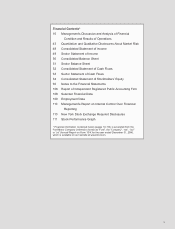Ford 2006 Annual Report Download - page 17
Download and view the complete annual report
Please find page 17 of the 2006 Ford annual report below. You can navigate through the pages in the report by either clicking on the pages listed below, or by using the keyword search tool below to find specific information within the annual report.
Management’s Discussion and Analysis of Financial Condition and Results of Operations
15
Working Together through Teamwork and Accountability
Our global management team is focused on a single, company-wide global business plan that establishes clear
performance goals for the entire Company. This requires all functions – product development, purchasing, information
technology, manufacturing, etc, – across the globe to work together and be accountable to meet the performance goals
established by our business plan.
To facilitate this, our senior management team has established weekly meetings to assess our progress against the
business plan goals, to identify risks to meeting and opportunities for exceeding those goals, and to make decisions about
actions to take to mitigate risks or implement opportunities to stay on track to meet or exceed those goals.
Financial Impact and Assumptions
Execution of the four priorities discussed above is expected to result in our Ford North America segment, and our
Automotive sector overall, being profitable in 2009. This projection is based on the following operating assumptions in the
2008 and 2009 time period:
x Sales volume and mix of products stabilizing in North America, with U.S. market share in the 14% to
15% range for Ford, Lincoln and Mercury brands, and lower fleet sales as a percentage of total sales. This in
part reflects cessation in 2006 of production of the Ford Taurus sedan in Atlanta and Ford Freestar and
Mercury Monterey minivans in Oakville, Ontario. In addition, we expect growth in sales volumes outside the
United States.
x Cumulative reduction in annual operating costs for our Ford North America segment of about $5 billion by the
end of 2008 compared with 2005, largely reflecting the personnel and capacity reductions discussed above,
and continuing cost improvements in 2009.
For a discussion of our liquidity needs and uses during this period, see "Liquidity and Capital Resources – Automotive
Sector"below. For a discussion of the outlook for our 2007 full-year performance, see "Outlook" below.
























